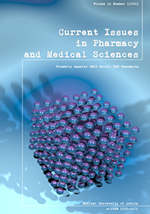Prevalence of aerobically growing opportunistic bacteria in the nasopharyngeal microbiota of pregnant women living in rural and urban areas
DOI:
https://doi.org/10.2478/cipms-2023-0031Keywords:
nasopharyngeal microbiota, pregnant women, pregnancy, place of residenceAbstract
The upper respiratory tract, including the nasopharynx, is inhabited by many microbial species. Still, the nasopharyngeal microbiota (or microbiome) of pregnant women is not well understood and may be influenced by a number of factors, including place of residence. Many changes occur during pregnancy, and their association with the respiratory microbiota is important for the health of the mother and for the developing fetus. The aim of this study was to compare the colonisation of the nasopharyngeal cavity by culturable aerobic bacteria in the microbiota of women with a physiological pregnancy course according to rural or urban place of residence. Nasopharyngeal swabs were collected from 37 pregnant women (17 from rural and 20 from urban areas) to detect the colonisation of aerobically growing culturable bacteria. Isolates were identified using microbiological culture methods and the MALDI-TOF MS technique. Bacteria were colonisers of the nasopharynx cavity in all cases tested. Accordingly, 97.3% (36/37) of the pregnant women were colonised by Gram-positive bacteria, mainly coagulase-negative (CoNS) and -positive (CoPS) Staphylococcus spp. and Corynebacterium spp. in both the rural and urban groups. Gram-negative Klebsiella variicola, Proteus mirabilis and Pseudomonas congelans colonised only 17.6% (3/17) of rural women and Stenotrophomonas maltophilia only 5.0% (1/20) of the urban women. To summarise, all pregnant women were colonised with bacteria in the nasopharyngeal cavity. The majority from both rural and urban residences were colonised with Gram-positive bacteria only. Gram-negative bacteria were isolated mainly from samples in the rural group.
References
1. Berg G, Rybakova D, Fischer D, Cernava T, Vergès M-CC, Charles T, et al. Microbiome definition re-visited: old concepts and new challenges. Microbiome. England; 2020:103.
2. Whipps J, Lewis K, Cooke R. Mycoparasitism and plant disease control. In: Burge M, editor. Fungi in biological control systems. Manchester: Manchester University Press; 1988:161-87.
3. Baquero F, Nombela C. The microbiome as a human organ. Clin Microbiol Infect. 2012;18 Suppl 4:2-4.
4. Dickson RP, Erb-Downward JR, Martinez FJ, Huffnagle GB. The microbiome and the respiratory tract. Annu Rev Physiol. 2016;78(1):481-504.
5. Kumpitsch C, Koskinen K, Schöpf V, Moissl-Eichinger C. The microbiome of the upper respiratory tract in health and disease. BMC Biol. 2019;17(1):87.
6. Hilty M, Burke C, Pedro H, Cardenas P, Bush A, Bossley C, et al. Disordered microbial communities in asthmatic airways. PLoS One. 2010;5(1):e8578.
7. Mesa MD, Loureiro B, Iglesia I, Fernandez Gonzalez S, Llurba Olivé E, García Algar O, et al. The evolving microbiome from pregnancy to early infancy: A comprehensive review. Nutrients. 2020 Jan;12(1).
8. DiGiulio DB, Callahan BJ, McMurdie PJ, Costello EK, Lyell DJ, Robaczewska A, et al. Temporal and spatial variation of the human microbiota during pregnancy. Proc Natl Acad Sci U S A. 2015;112(35):11060-5.
9. Han YW, Fardini Y, Chen C, Iacampo KG, Peraino VA, Shamonki JM, et al. Term stillbirth caused by oral Fusobacterium nucleatum. Obstet Gynecol. 2010;115(2 Pt 2):442-5.
10. Chu DM, Ma J, Prince AL, Antony KM, Seferovic MD, Aagaard KM. Maturation of the infant microbiome community structure and function across multiple body sites and in relation to mode of delivery. Nat Med. 2017;23(3):314-26.
11. Hang J, Zavaljevski N, Yang Y, Desai V, Ruck RC, Macareo LR, et al. Composition and variation of respiratory microbiota in healthy military personnel. PLoS One. 2017;12(12):e0188461.
12. Kosikowska U, Chwiejczak E, Dłuski D, Stępień-Pyśniak D, Leszczyńska-Gorzelak B, Malm A. Różnorodność gatunkowa Staphylococcus spp. w mikrobiocie nosogardzieli kobiet ciężarnych. In: III Ogólnopolska konferencja ”Drobnoustroje w świecie człowieka – Drobnoustroje oportunistyczne”. Bydgoszcz; 2018.
13. Meshcheriakova AK, Kostinov MP, Magarshak OO, Zaĭtseva EV. Species and quantitative characteristics of pharyngeal mucosa microflora in pregnant women. Zhurnal Mikrobiol Epidemiol Immunobiol. 2014;(2):93-7.
14. Callewaert C, Ravard Helffer K, Lebaron P. Skin microbiome and its interplay with the environment. Am J Clin Dermatol. 2020;21(Suppl 1):4-11.
15. Nuriel-Ohayon M, Neuman H, Koren O, Fujiwara N, Tsuruda K, Iwamoto Y, et al. Geography, ethnicity or subsistence-specific variations in human microbiome composition and diversity. Front Microbiol. 2017;8(1):215-29.
16. Nuriel-Ohayon M, Neuman H, Koren O. Microbial changes during pregnancy, birth, and infancy. Front Microbiol. 2016;7:1031.
17. Balan P, Brandt BW, Chong YS, Crielaard W, Wong ML, Lopez V, et al. Subgingival microbiota during Healthy Pregnancy and Pregnancy Gingivitis. JDR Clin Transl Res. 2021;6(3):343-51.
18. Balan P, Chong YS, Umashankar S, Swarup S, Loke WM, Lopez V, et al. Keystone species in pregnancy gingivitis: A snapshot of oral microbiome during pregnancy and postpartum period. Front Microbiol. 2018;9:2360.
19. Amir M, Brown JA, Rager SL, Sanidad KZ, Ananthanarayanan A, Zeng MY. Maternal microbiome and infections in pregnancy. Microorganisms. 2020;8(12).
20. Fujiwara N, Tsuruda K, Iwamoto Y, Kato F, Odaki T, Yamane N, et al. Significant increase of oral bacteria in the early pregnancy period in Japanese women. J Investig Clin Dent. 2017;8(1).
Downloads
Published
Issue
Section
License
Copyright (c) 2023 Authors

This work is licensed under a Creative Commons Attribution-NonCommercial-NoDerivatives 3.0 Unported License.


